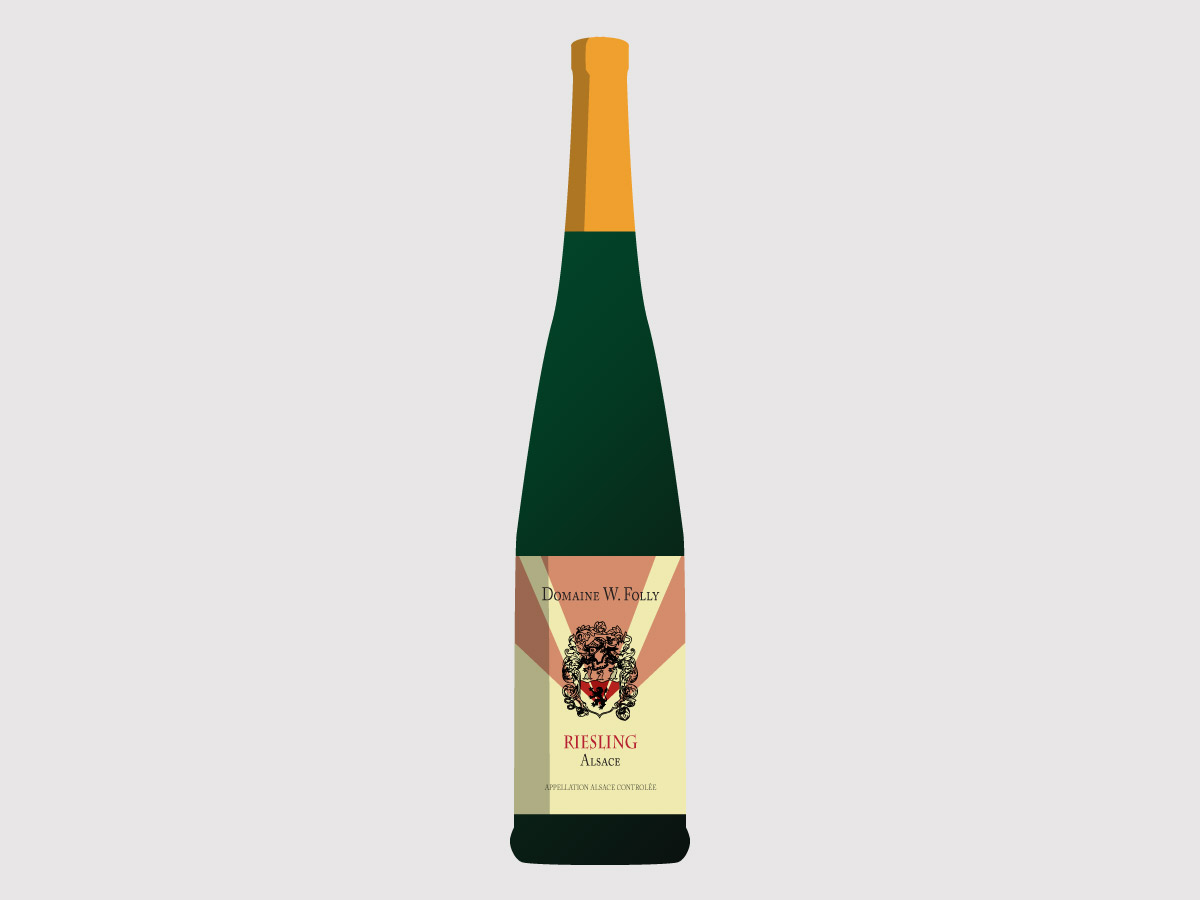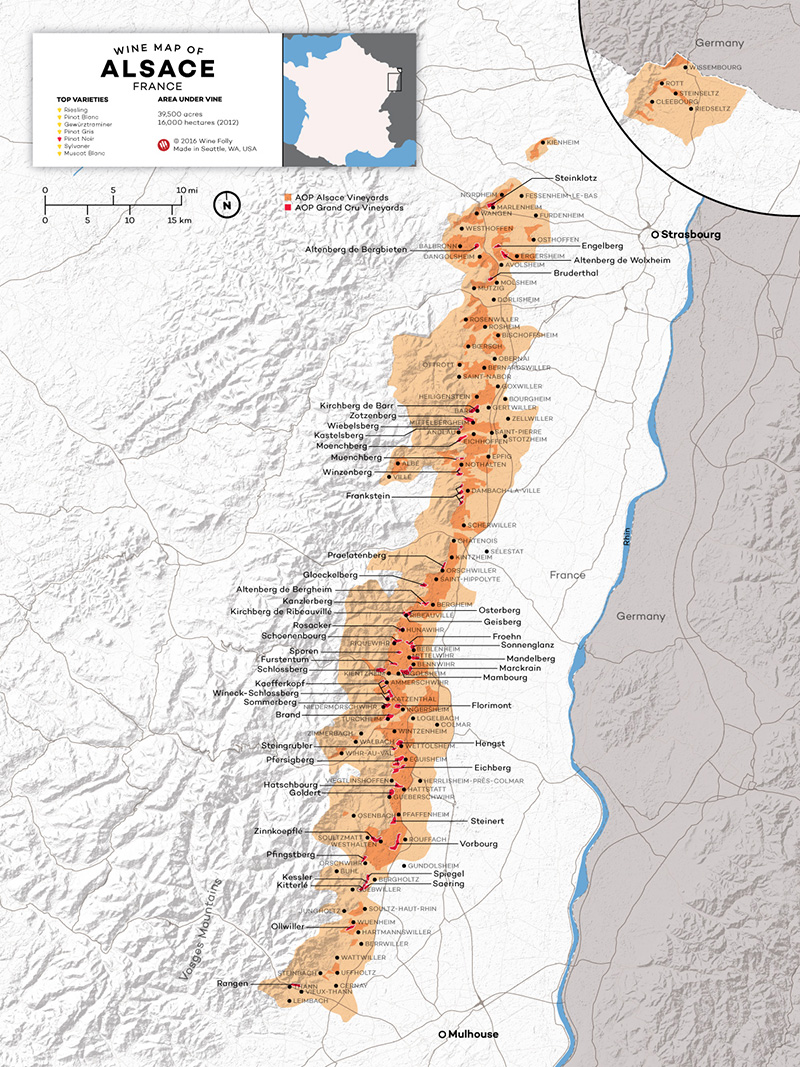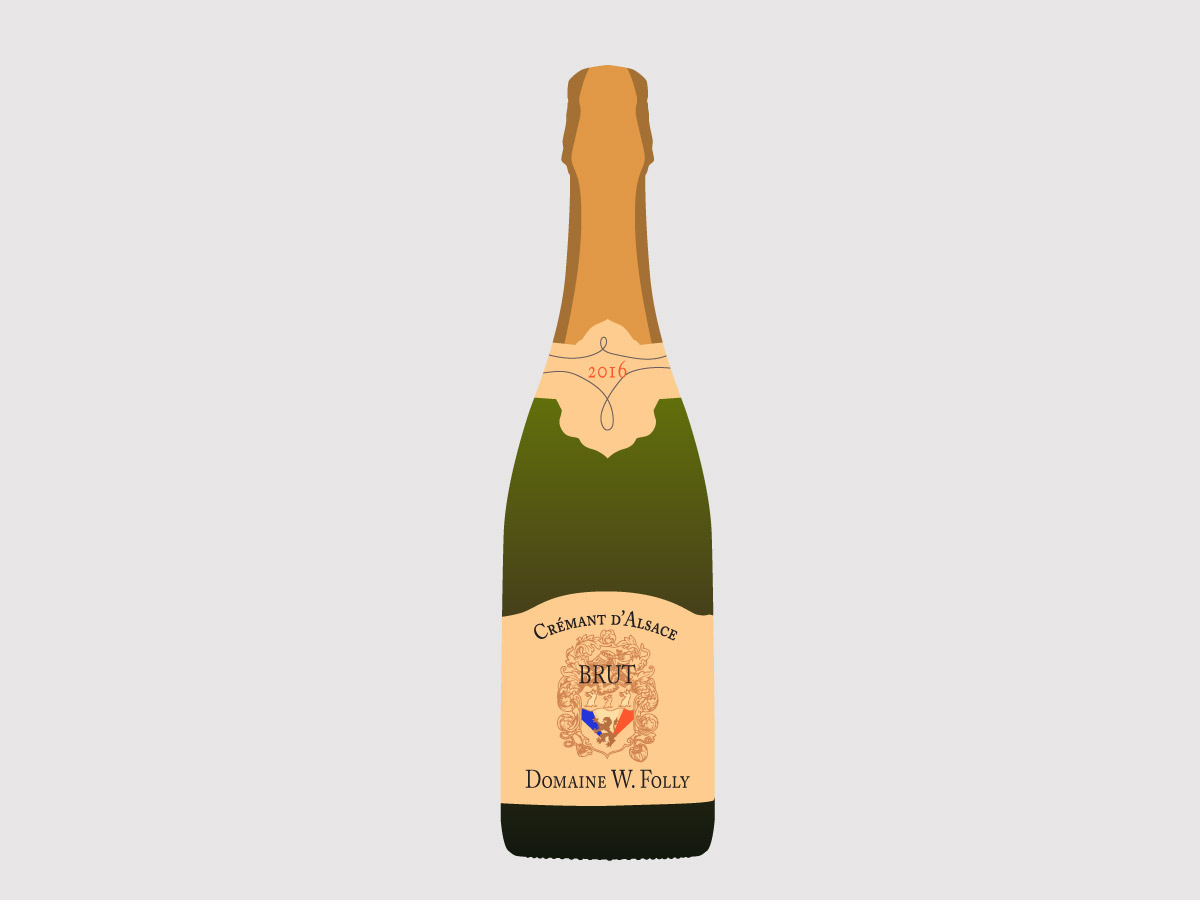Learn how to find great Alsatian wines on your own by understanding the region’s wine classification system. You’ll learn about the styles of Alsatian wines and how the varied soils affect top wines, including Riesling, Gewürztraminer, and Pinot Gris.
Alsace Wine: A Guide For Oenophiles
For those who realize that white wine can be serious, Alsace is a region you’ll gravitate toward. The Alsatian grapes Riesling, Gewürztraminer, and Pinot Gris create wines that are among the best and most age-worthy in the world. Despite the region’s scientific complexity (it has varied soil types), its classification system makes it easy to identify quality.
Alsace Wine Classifications

The wines of Alsace use a specially shaped bottle, or Flûte d’Alsace, which is recognizable by its slender, pointed shape.
Alsace AOP
Aromatic white wines with surprising quality for value
The basic wine of Alsace is from the encompassing area of 119 communes (little villages). If a wine is labeled with a variety (e.g. “Riesling” or “Pinot Blanc” etc.), that means it will contain 100% of that variety (most varietal wines are labeled with just 75–85% of variety, so this is rare!). The Alsace AOP classification is a great way to get familiarized with Alsatian wines.
Expect to spend: $12–$20 a bottle
Popular Wines: Riesling, Gewürztraminer, Pinot Gris and Sylvaner
Tips:
- Pinot Gris is off-dry: Alsatian producers tend to produce Pinot Gris in a slightly sweeter style with notes of peach, tangerine, beeswax, and almond. There are a few producers making dry Pinot Gris, and because it is rare, it will likely be indicated on the label.
- The 4 “Noble” Grapes: Over the centuries, Alsatian growers identified a selection of varieties that produced exceptional wines in the region and called them the “noble” grapes: Riesling, Gewürztraminer, Pinot Gris and Muscat (Muscat Blanc or Ottonel).
- Pinot d’Alsace: Pinot d’Alsace is a blend of the Pinot varieties (P. Noir, P. Gris, P. Blanc and sometimes Auxxerois) that is made into a succulent, dry, golden-colored white wine.
- The Alsatian “Gentil” Blend: Gentil is a term used on bottles of basic Alsace AOP that are a blend of at least 50% “noble” varieties (Gewürztraminer, Riesling, Pinot Gris and Muscat) with the remainder being the other regional white grapes of Chasselas, Pinot Blanc and/or Sylvaner.
- Cool-climate Pinot Noir: There are subzones (Saint-Hippolyte, Rodern and Ottrott) that only make red wines of Pinot Noir labeled simply as “Rouge.” By the way, red wines from Alsace generally offer bright, tart red fruit flavors, herbal notes and a spicy finish.
- Alsace Rosé: Alsatian still rosé is made exclusively of Pinot Noir.
- Sylvaner, Chasselas, Pinot Blanc and Auxerrois: The lesser-known (but still widely planted) varieties of Alsace are mostly used in blends and tend to produce less intensely flavored and less acidic (than Riesling) with apple, peach and pear flavors. Of these other Alsace grapes, Sylvaner is arguably the most important as a single-varietal wine.
Crémant d’Alsace AOP
Excellent alternative to Champagne
The sparkling wines of Alsace are a must-try for sparkling wine fans. The two styles, blanc (brut) and rosé, are made with the same technique as Champagne but with different grapes.
Expect to spend: $17–$23 a bottle
Wines
- Crémant d’Alsace Brut: A blend or single varietal wine using Riesling, Pinot Blanc, Pinot Noir, Pinot Gris, Auxerrois, and/or Chardonnay. Wines tend to have rich, apple and sweet lemon aromas with small spritzy bubbles. Pay attention to the blends, and you’ll be surprised to find the quality producers have a dominance of Pinot Gris, Riesling and Chardonnay.
- Crémant d’Alsace Rosé: This is the real find with Alsatian bubbly, as it’s required to be 100% Pinot Noir. Wines have rich floral aromas with strawberry and cinnamon-like spice.
Alsace Vineyard Map

This map details 51 Grand Cru Appellations of Alsace. Get it map in the Wine Folly Shop
Buy Map
Alsace Grand Cru AOP
Subtle, smoky white wines with serious depth
The highest-end wines are produced in 51 different sites throughout Alsace with the noble varieties of Riesling, Gewürztraminer, Pinot Gris and Muscat. What makes these sites more special than others usually involves the vineyard’s southern exposure to receive the most sun (it’s a cool-climate region, so ripening is tricky) and soils. Unlike other wine regions, Alsace has extremely varied soil types in the region, and you’ll notice a few themes with the soils as they pertain to fine wine:
- Rocky granitic soils: usually ideal for aromatic Riesling wines
- limestone-rich clay soils (aka marl): better for rich-textured Gewürztraminer or Pinot Noir
- Volcanic soils: which can make smoky Pinot Gris, aromatic Pinot Noir and Riesling wines
- Sandstone soils: Known for producing lighter-bodied and leaner white wines
TIP: The appellation of Zotzenberg is allowed to use Sylvaner in Grand Cru-labeled wines.
Expect to spend: $30–$80 a bottle
Popular Grand Cru Wines (by Vineyard): Clos Ste Hune (Trimbach), Clos de la Treille (F. Baur), Clos St Urbain (Zind-Humbrecht), Clos St Théobald (Schoffit), Clos St Imer (E. Burn), Clos Gaensbroennel (Willm), Clos Zisser (Dom. Klipfel), Clos du Zahnacker (La Cave de Ribeauvillé), Clos Schild (Lucien Albrecht), Clos St Landelin (R. Muré)
Short on Alsace Wines
The Wines of Alsace from GuildSomm on Vimeo.
Guildsomm created a great 10 minute primer on the region. You’ll get to see the wines, the region and its varied soils.

